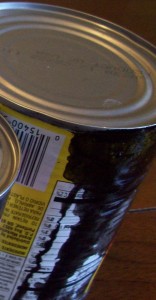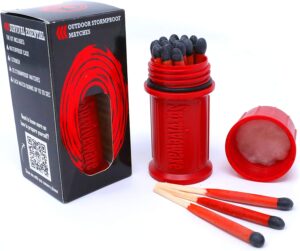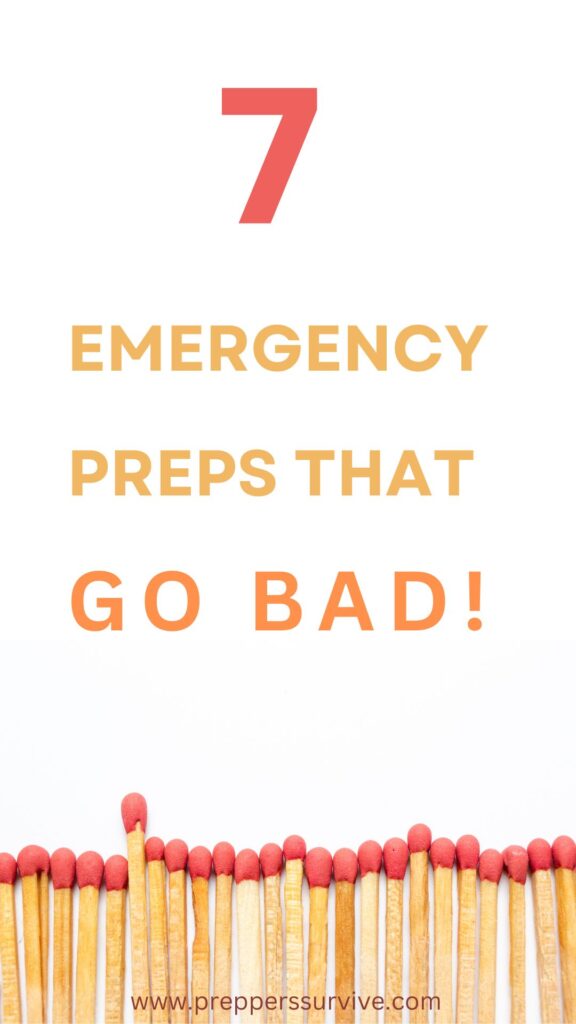In a world full of uncertainties, staying prepared is vital for self-sufficiency until help arrives. Having an emergency plan in place and emergency supplies on hand can increase you and your family’s chances of survival during a crisis. 7 Preps You May Be Surprised GO BAD!
However, not all goods are created equal; some may have a shorter shelf life than others. It’s easy to assume that once you’ve purchased your survival gear and stocked up on supplies, you’re all set for any emergency situation. But what happens when you discover that some of your survival prep goods have gone bad in storage?
In this article, we’ll explore some common goods that can surprisingly spoil or lose their effectiveness over time, especially when they are not stored properly. So grab a pen and paper to take notes to check if you have them!
- Canned goods

Do you know what’s worse than facing a disaster? Digging into your food stockpiles only to find that your canned food has gone bad!
One of the biggest mistakes newbie preppers tend to forget is that canned foods can go bad. Yes, they’re sterilized and airtight, but they can also lose their freshness and flavor over time or become contaminated. Moreover, the expiration date is often not just a suggestion to keep things fresh but also a warning. According to the USDA, canned goods can last anywhere from 12-18 months for high-acid foods like tomatoes and citrus, and 2-5 years for low-acid foods like meats and veggies.
So let’s say you’re facing a disaster and find a very old can of beans. It might still be safe to eat, but it’ll taste like a mouthful of regret. And if air manages to sneak into the can, things can get dangerous. Botulism, caused by bacteria that can paralyze or kill you, can easily grow and thrive in those conditions. You don’t want to put your or your family’s health at risk in the midst of a disaster, so tossing the old can of beans might actually save you from harm!
2. Dried beans
Think your dried beans can’t go bad? Think again! Sure, they’ve been through a drying process that can make them last longer than their fresh counterparts, but they’re not invincible.
If you store your dried beans properly in an airtight container in a cool, dry place, they can last up to two years. But the longer they sit, the longer they’ll take to cook! And let’s face it, that will cost a lot of energy and fuel. If the beans are too old, you might find it impossible to soften them on the stove.
Plus, the flavor won’t be as appetizing as it once was. And don’t even get me started on mold and bacteria. Work this info into a rotation program for old stock. If you notice anything funky, toss those bad boys out. Trust me, your taste buds and stomach will thank you!
3. Brown rice

So, you think brown rice lasts forever? While most rice varieties can sit on your pantry shelf for ages, uncooked brown rice is definitely not on the list! Brown rice is said only to have a shelf life of six to eight months, thanks to the higher oil content in the bran. And if you want to extend its life, stick it in the fridge or freezer. Just don’t expect it to last as long as that bag of frozen peas that’s been in there for a decade.
And let’s be real, who wants to eat rancid rice (not me, that’s for sure)! Trust me, you’ll know when your brown rice has gone bad. Just give it a sniff – if it has an unpleasant odor, it’s time to consider chucking it out! And if you see any insects crawling around in your rice, that’s a whole other story. Toss the rice in the compost bin if you see meal moths and weevils on your grains.
But wait, there’s more! Brown rice can also grow mold if it’s not stored properly. So keep it in a sealed container and in a cool place. If you see any mold growth, don’t even think about it – toss it out! Eating moldy rice is not worth the risk of digestive discomfort.
4. Opened bottles of oil or jars of sauce
If you’re a fan of cooking at home, you probably have a variety of sauces and oils in your pantry to enhance the flavor of your dishes. However, did you know that opened jars of sauce or bottles of oil can spoil easily if not refrigerated or stored properly?
When a jar of sauce or bottle of oil is opened, it’s exposed to air and other contaminants that can cause it to spoil. The high acidity and sugar levels in some sauces can create an environment perfect for bacteria growth, leading to an increased risk of food poisoning. Moreover, oils can go rancid when exposed to oxygen and heat for long periods.
Unfortunately, during a long emergency, you will not have access to a freezer or clean storage area. So the quality of oil or sauces and how they are stored as part of your emergency kit matters!
Before adding your favorite sauce or oil to your emergency checklist, make sure to always check their labels for storage instructions. If it says “refrigerate after opening,” make sure to follow that advice. Store these items in a cool, dry place away from direct sunlight and heat sources like stoves or ovens. For oils, it’s best to keep them in a dark-colored bottle or cupboard to prevent light exposure, which can cause oxidation. 7 Preps You May Be Surprised GO BAD!
Lastly, make sure to use a clean spoon or utensil every time you dip into the jar or bottle. Avoid using your fingers or a dirty spoon, as it can introduce bacteria into the product.
5. Nuts
When it comes to packing a survival kit, many people might opt for nuts as a source of protein. While nuts are undoubtedly a nutritious and energy-packed food, it’s important to consider their shelf life when including them as part of your survival food. Nuts contain oils that can go rancid over time, especially if they are exposed to heat, light, or air. Yes, peanut butter fits into this category because of its oily nature. A nut’s age affects its taste, texture, and nutritional value.
Typically, nuts last about 3-6 months when stored at room temperature. However, if you want to extend their shelf life, it’s best to store them in an airtight container in the refrigerator or freezer. This will help to slow down the oxidation process and keep the nuts fresh for up to a year.
The type of nuts you choose also matters! Some nuts, such as almonds and cashews, have a higher fat content than others and are more prone to rancidity. If you’re looking for nuts with a longer shelf life, you should opt for varieties like walnuts, pecans, or hazelnuts instead. These nuts have a lower fat content and are less likely to go rancid quickly.
6. Matches

Who knew that something as small as a match could cause such a stir? I mean, we’ve been using them for years to start fires, but did you know they also have a shelf life? Yep, just like your canned goods, these little guys have an expiration date. And let’s be real; nobody wants to be stuck in a survival situation with a dud match.
But not all matches are created equal, folks. Those little matchbooks you get at hotels or liquor stores? Unfortunately, those won’t last long. And don’t even get me started on the standard matchbox matches you can buy at the supermarket. Strike-anywhere matches are a whole other ballgame – they’re like the bad boys of the match world. If you placed them in the bag or in your pocket, these little guys can quickly ignite and cause accidents!
If you’re serious about being prepared, you should invest in some waterproof matches or stormproof matches. They last a lot longer than your average match!
7. Ammunition for hunting
Last, on the list of preps you may be surprised go bad is ammunition. Storing ammunition is not as simple as chucking it in the back of your closet and forgetting about it, much like your perishable groceries. You need to take into account factors such as moisture, temperature, light exposure, and proper sealing to ensure your ammo doesn’t go bad. Before you fire your weapon, make sure you’re not using bad ammo, or you could end up causing harm to your gun and yourself.
Remember, just like a fine wine, your ammo has a shelf life that varies depending on how you store it. So, be sure to use your oldest ammo first and keep an eye on any rounds that you’ve taken out of storage but haven’t used. And don’t forget, investing in a system designed for ammunition storage is the way to go if you want to keep your ammo in top-notch condition.
Wrapping it up
Were there any surprises on the 7 Preps You May Be Surprised GO BAD list? If so, please leave us a comment below.
Being prepared for a natural disaster can help you protect your family and home when help is unavailable. But one of the biggest challenges preppers face is storing goods that will last for long periods of time without being contaminated or losing their usefulness. Hence, it’s important to consider their shelf life when including them as part of your survival goods.
Remember that the whole point of your survival prepping is to keep you and your family safe and have resources in case of major calamities or disasters. It’s like having a secret weapon up your sleeve that keeps life’s curveballs in check. One way to keep your preps usable is to rotate them so that all of your goods, like food, matches, and ammunition, remain in tip-top shape.
Thanks for visiting this Survival Prepping website! Before you leave, subscribe to our emails. If you have a moment, please share this article, 7 Preps You May Be Surprised GO BAD, on your favorite social media.

The post 7 Preps You May Be Surprised GO BAD! appeared first on Survival Prepper.
By: PreppersSurvive
Title: 7 Preps You May Be Surprised GO BAD!
Sourced From: www.prepperssurvive.com/7-preps-you-may-be-surprised-go-bad/
Published Date: Wed, 10 May 2023 22:15:47 +0000
-------------------------------------------------------------------------
Did you miss our previous article...
https://outdoorsnewswire.com/survivalist/best-expandable-baton-for-self-defense
 CampingSurvivalistHuntingFishingExploringHikingPrivacy PolicyTerms And Conditions
CampingSurvivalistHuntingFishingExploringHikingPrivacy PolicyTerms And Conditions
